基于功能化活性炭填充金纳米粒子的超级电容器电极纳米复合材料
IF 0.5
Q4 ENGINEERING, CHEMICAL
引用次数: 0
摘要
在超级电容器的电极中使用活性炭似乎很有前途。当活性炭用双氧水溶液处理时,形成含氧官能团-主要是羰基。(这个过程被称为功能化。)这导致电容大约增加40%。如果在生成的材料中引入填料- 2 wt %的金纳米颗粒,则其孔隙结构不会被阻塞。通过这种方法,电容可以进一步增加~10%。这种纳米结构电极材料的电容量在电位重复循环(高达500次循环)中非常稳定(~86%)。本文章由计算机程序翻译,如有差异,请以英文原文为准。

Electrode Nanocomposites of Supercapacitors Based on Functionalized Activated Charcoal Filled with Gold Nanoparticles
The use of activated charcoal in electrodes for supercapacitors seems very promising. When activated charcoal is treated with aqueous hydrogen peroxide solution, oxygen-bearing functional groups are formed—primarily carbonyl groups. (This process is known as functionalization.) That results in approximately 40% increase in the electrical capacitance. If filler—2 wt % gold nanoparticles—is introduced in the resulting material, its pore structure is not blocked. By this means, the electrical capacitance may be increased by a further ~10%. The electrical capacitance of this nanostructured electrode material proves very stable (~86%) in repeated cycling of the potential (up to 500 cycles).
求助全文
通过发布文献求助,成功后即可免费获取论文全文。
去求助
来源期刊

Coke and Chemistry
ENGINEERING, CHEMICAL-
CiteScore
0.70
自引率
50.00%
发文量
36
期刊介绍:
The journal publishes scientific developments and applications in the field of coal beneficiation and preparation for coking, coking processes, design of coking ovens and equipment, by-product recovery, automation of technological processes, ecology and economics. It also presents indispensable information on the scientific events devoted to thermal rectification, use of smokeless coal as an energy source, and manufacture of different liquid and solid chemical products.
 求助内容:
求助内容: 应助结果提醒方式:
应助结果提醒方式:


